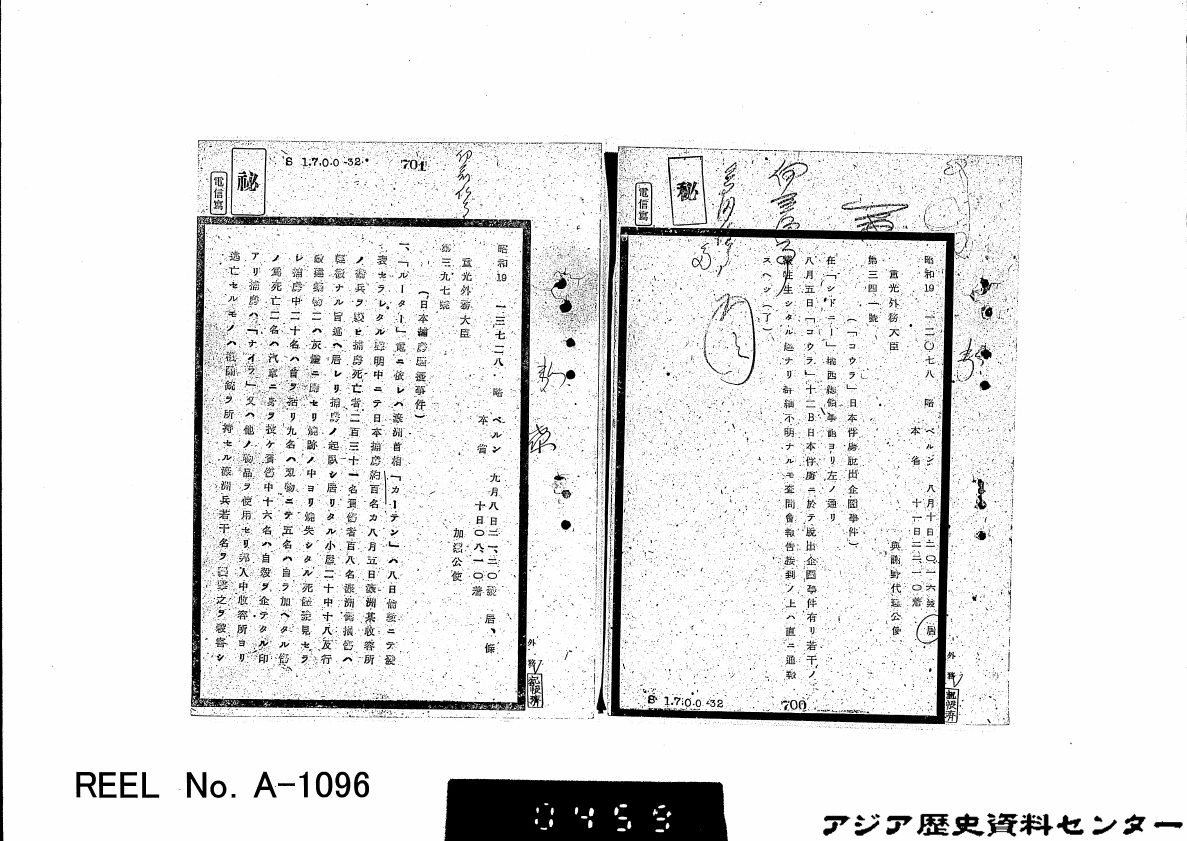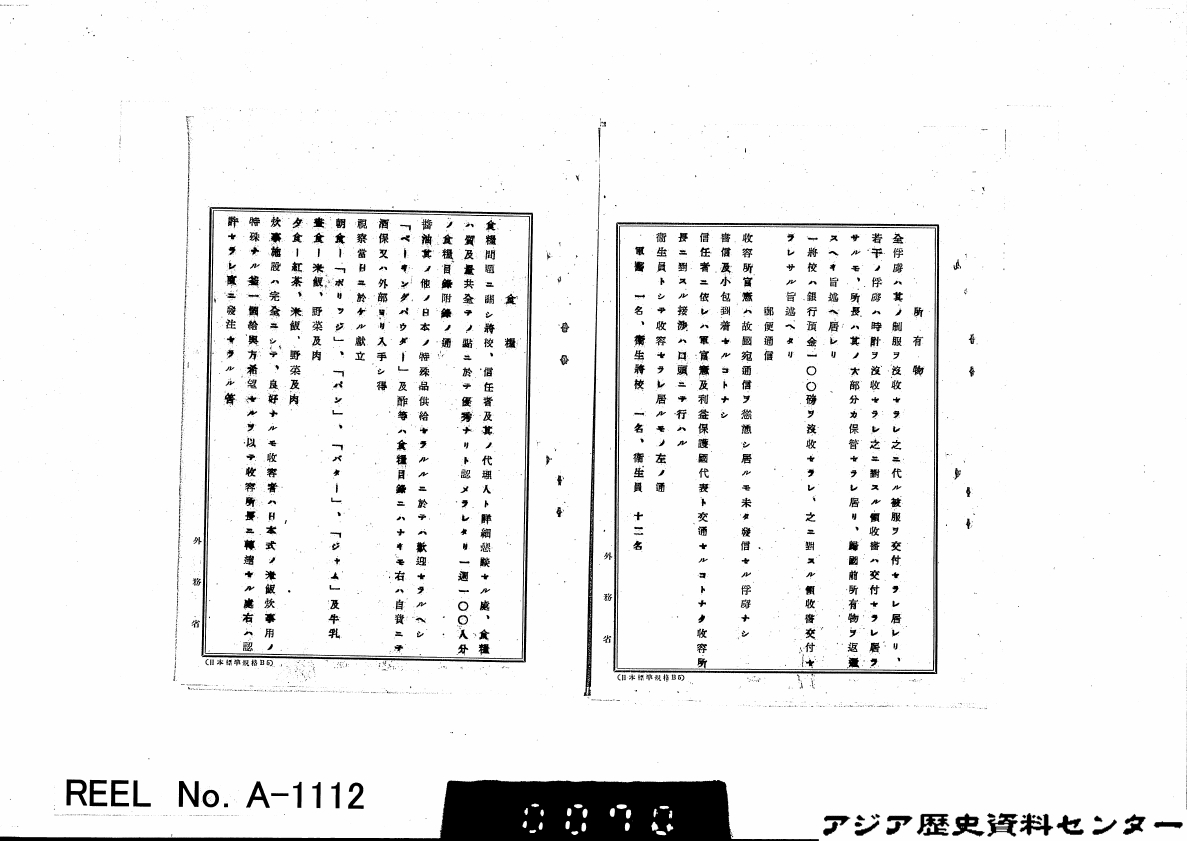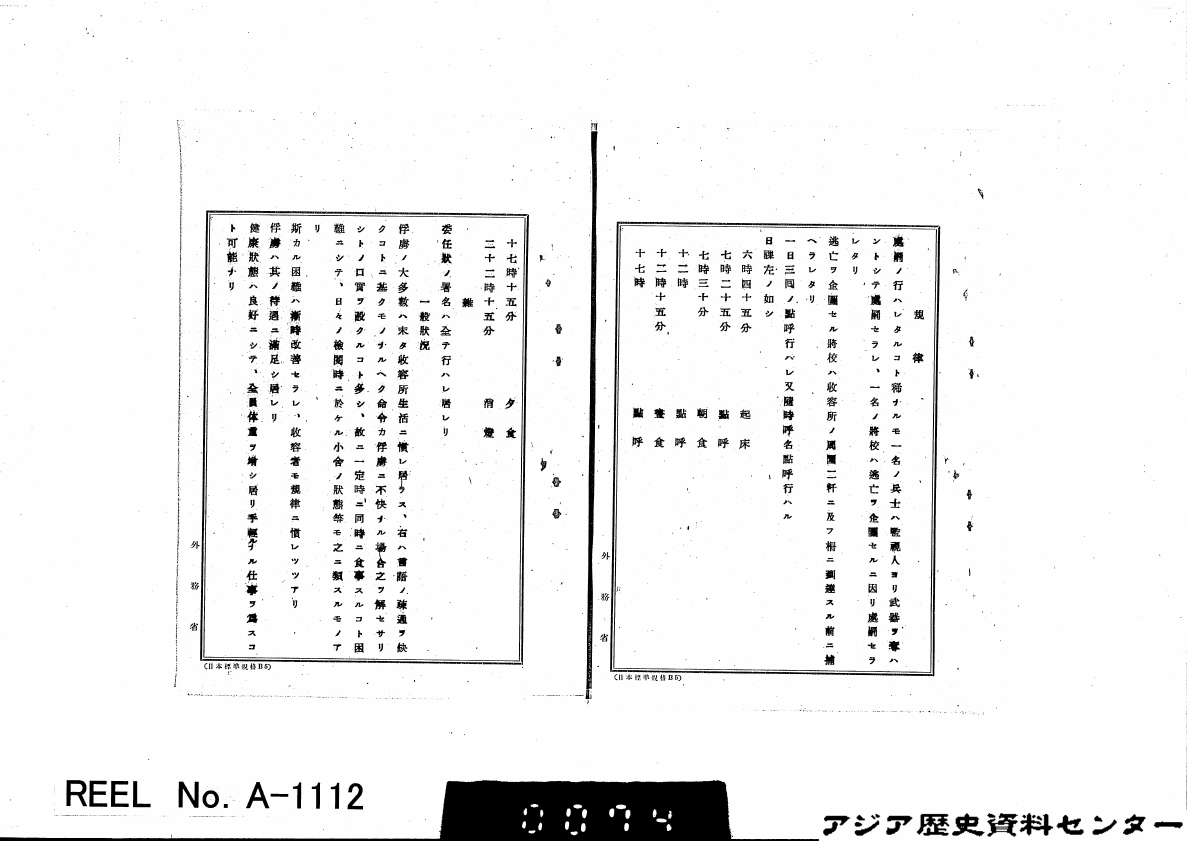JACAR Newsletter
JACAR Newsletter Number 31
March 31, 2020
Contents
Documents Spotlight
The Cowra Breakout
On August 6 and 9, annual memorials are held to commemorate the victims of the atomic bombs dropped upon Hiroshima and Nagasaki. A few days later, on August 15, Japanese observe the anniversary of the end of the Second World War. For many Japanese, at this time of the year, this all offers an opportunity to reflect upon the tragedies of war and appreciate peace.On August 5, 1944, almost a year before the atomic bombs dropped, 1,100 Japanese prisoners of war attempted a mass escape from Cowra Prison of War Camp in Australia. This resulted in the deaths of 231 Japanese and four Australians soldiers. In Australia there is a cemetery that was erected to honor those involved, but few know of this breakout in Japan.
Every year on August 5, both Japanese and Australian officials attend an Australian municipally organized memorial ceremony. I attended one such event and learned a great deal when previously working in the Consulate-General of Japan in Sydney. I felt ashamed of my ignorance in not knowing more about how Australians once perceived Japanese as enemies and yet they buried Japanese in the same cemeteries as their own war dead.
What happened in Cowra can also be understood through the dispatch records of the Japanese Ministry of Foreign Affairs as released online by JACAR. The Japanese legation in Switzerland in the 1940s had been sending via diplomatic cable to the Foreign Affairs headquarters in Tokyo reports received by the Swiss government written by staff at Switzerland’s consulate-general in Australia. We can assume from this that the Japanese government had some knowledge of prison conditions prior to the breakout. Accordingly, I want to examine that background, the incident, and its aftermath here with the JACAR database.
 [Image 1] Japanese Telegram from the Ministry of Foreign Affairs in Switzerland to report on the incident (2. Protests toward Britain (including territories and possessions) / 7. Incident of mass escape (protest to Australia) (Ref B02032491300, second image).
[Image 1] Japanese Telegram from the Ministry of Foreign Affairs in Switzerland to report on the incident (2. Protests toward Britain (including territories and possessions) / 7. Incident of mass escape (protest to Australia) (Ref B02032491300, second image).The particulars of the breakout can be confirmed from a report included among the Ministry of Foreign Affairs diplomatic cable records of the time (Ref. B02032491300, see 8th to 17th images). This report was produced by an Australian Military Court of Inquiry on the incident that the Swiss Consulate General in Sydney obtained from Australia’s Department of External Affairs (predecessor to today’s Department of Foreign Affairs and Trade). Much of the information was gathered by a committee that took testimonies from over 60 witnesses between August 7 and 15, 1944, after the Cowra breakout.
Details
● On August 5, 1944 1:50 AM, unauthorized trumpet sounds were heard in Block B. Over 900 POWs then charged their enclosing fence while yelling.
● POWs broke through two places in the prison fence. Another group broke through the fence that separated their quarters from the prison camp road.
● Before leaving their quarters, POWs set fire to them.
● POWs polished and sharpened more than 1,000 table knives with a saw tooth as weapons for attack. They also fashioned bread knives into swords along with baseball bats and clubs.
● POWs wore baseball mitts and other gloves to protect their hands as they climbed over the barbwire fence. Three blankets were also used to get beyond the barbwire. Many POWs wore extra clothing and wrapped towels around their bodies. They used ropes made from rice bags.
● August 14, 1944 9:00 AM, Japanese casualties were confirmed as follows: One officer was killed, 230 other soldiers were killed or died due to injury or suicide. One officer was injured along with ten other soldiers and people (Note: a report from the head of New South Wales to the federal chancellery held by the Australian National Archives states that 107 soldiers were injured.)
● At the funeral of a Japanese officer, two Japanese officers and four other soldiers carried a coffin with an elder Australian military officer.
Australia military casualties were as follows:
● One officer died and three soldiers passed away. Four soldiers were wounded.
A few Japanese prisoners escaped successfully, but within a few days everyone had been recaptured. Why would people dare to leave the prison camp in the dead of winter? Even if they got out, the nearest harbor for escape was in Sydney, more than 300 kilometers away. Did a harsh internment drive these seemingly reckless actions? Actually there are no indications that the treatment of the POWs was poor. A report of camp visits conducted by staff from the Swiss consulates in Melbourne and Sydney (again obtained by the Foreign Affairs Ministry through its legation in Switzerland) indicate that the Australians were surprisingly humane [Image 3]. The reports were conducted on May 27, 1943; July 29-31, 1943; September 6, 1943; and January 6, 1944.
Treatment Description
Treatment of Property:
Some POWs had their watches confiscated but were issued a receipt.
Diet in the Camp:
Breakfast: porridge, bread, butter, jam and milk.
Lunch: cooked rice.
Dinner: tea, cooked rice, vegetables and meat.
35 weeks of cigarettes.
Sanitation There were sanitary facilities and no complaints. An ophthalmologist visited once a month.
Labor
Since paid work requires a robust body, the number of employees was low. The employment rate was only 8%, and most were engaged in garden arrangement, logging, and chopping wood.
Exercise and entertainment Baseball, basketball, football and sumo wrestling.
Food target for 1,000 people per week
Beef: 100 pounds, mutton: 25 pounds, pork: 100 pounds, fresh fish: 300 pounds, eggs: 8.5 dozen, bread: 420 pounds, butter: 24.5 pounds, biscuits: 5 pounds, rice: 700 pounds, sugar: 105 pounds, vegetables: 170 pounds, etc.
 [Image 3] Report of inspection tour of prisoner camp of Japanese nationals in enemy countries (2. Cowra POW camp in Australia, 2) (Ref. B02032530400, 4th image).
[Image 3] Report of inspection tour of prisoner camp of Japanese nationals in enemy countries (2. Cowra POW camp in Australia, 2) (Ref. B02032530400, 4th image). [Image 3] Report of inspection tour of prisoner camp of Japanese nationals in enemy countries (2 Moura Koura Camp 2) (Ref. B02032530400, 8th image).
[Image 3] Report of inspection tour of prisoner camp of Japanese nationals in enemy countries (2 Moura Koura Camp 2) (Ref. B02032530400, 8th image).
The Australian soldiers [of Cowra] seemed to work freely without concern for efficiency. They went on picnics and took extra breaks... there was plenty of food, and more biscuits than could be eaten, so the excess food was incinerated. It was wasteful considering how there was a shortage of food in Japan. Since Japanese eat rice, prisoners were given rice and imported fish from New Zealand (Jiro Tsuneichi, “Escape from Cowra POW Camp” (Shinhihyō, August 1972)
Despite being something of an ideal camp, the POWs chose to risk death for escape. The fundamental reason that drove this may be found in Japan’s Senjinkun [Field service code]. It inculcated people with the message: “If alive, do not suffer the disgrace of becoming a prisoner; in death, do not leave behind a name soiled by misdeeds.” Therefore POWs who died used pseudonyms to avoid shame. So the actual names of the prisoners in graves erected after the incident are unknown. This all prompts thoughts of how deeply imprinted Japanese value systems were within the soldiers during their internment.
Ironically, the breakout provided an opportunity for Japan and Australia to reconnect in the war’s aftermath. Although the place where this incident occurred today does not have any of the original buildings left, a metal signboard with information commemorates the site of the POW camp. It has become a place where many people including Japanese visit [Image 4]. After the war, the site of the POW camp was cleaned up, and both a cemetery for Japanese war dead and later the largest Japanese garden in the southern hemisphere were established in Cowra [Image 5].
Furthermore, a street named Sakura Avenue for the cherry trees planted along it was created that connects the Japanese garden to the prison camp. Sakura Matsuri (Cherry Blossom Festival) is held every year when the trees flower in September. And following a proposal from the mayor of Cowra, a student exchange program started in 1970 between Cowra High School and Seikei High School, and is still going. In 2003, at the site of the POW camp, a peace and friendship agreement was signed between Cowra and Joetsu City of Niigata Prefecture. Exchanges including homestays take place.
In this way, a site of suffering in Cowra is now a symbol of reconciliation and peace. Thanks to the unremitting efforts of many, a friendship between Japan and Australia has blossomed.
[References]
永瀬隆、吉田晶編『カウラ日本兵捕虜収容所」(青木書店、1990年)
鎌田真弓編『日本とオーストラリアの太平洋戦争』(お茶の水書房、2012年)
スティーブ・ブラード著、田村恵子訳『鉄条網に掛かる毛布』(オーストラリア戦争記念館発行、2006年)
土屋康夫著『カウラの風』(KTC中央出版、2004年)
Koichi Tsuchida, Senior Specialist for Archival Affairs, JACAR
share





